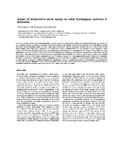Impact of deltamethrin aerial sprays on adult Cyrtobagous salviniae in Botswana

Date
2010-12-22Author
Kurugundla, C.N.
Bonyongo, M.C.
Serumola, O.
Publisher
Taylor & FrancisType
Published ArticleMetadata
Show full item recordAbstract
The risk and effect of the insecticide deltamethrin, applied aerially in Botswana to control and eradicate tsetse fly, was studied on the non-target weevil Cyrtobagous salviniae, a biocontrol agent of the aquatic weed Salvinia molesta. Environmentally-simulated short-term toxicity bioassay used open iron cages and closed plastic basins containing weevils and salvinia placed in riverine water bodies, where they were exposed to the aerial applications of deltamethrin over the Kwando–Linyanti system in 2006. Control samples were placed 40 km outside the sprayed area. Weevil mortality, determined at 12, 36 and 60 hours after the aerial application, reached a maximum of 27%. No significant difference in mortalities was observed between the closed basins and the open cages. The amount of deltamethrin deposited at ground level was between 1.2 and 6.4 μg m–2 and the insecticide toxicity was related to the weevil mortality. Simultaneous field monitoring through five spray applications showed that weevil abundance declined in late winter. Deltamethrin had a negligible impact on the weevil’s ability to control salvinia under field conditions, probably due to the weevils’ protective mechanism and because vegetation could act as a barrier, preventing the insecticide from reaching the weevils. Minimum impacts of deltamethrin on the weevils in the present study and their recovery in the field are consistent with those of earlier spray applications in the Okavango Delta, Botswana.
Collections
- Research articles (ORI) [270]
